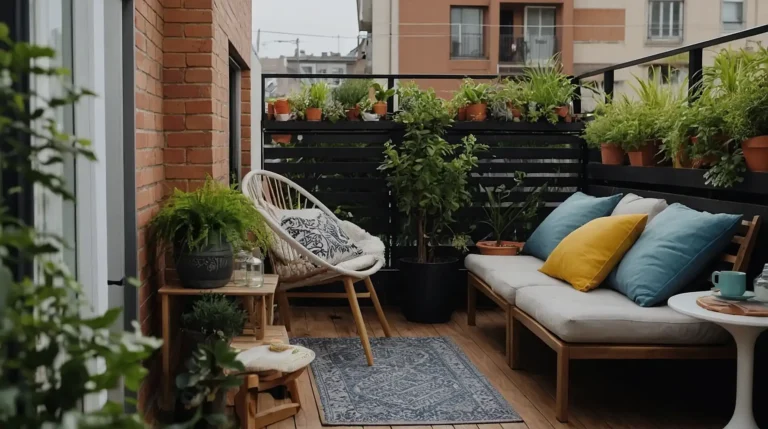35 Whimsical Dr. Seuss Classroom Door Ideas That Will Make Your Students Smile
Transform your classroom entrance into a magical Seuss Ian world that welcomes students with color, creativity, and imagination.
Dr. Seuss decorations create an instant atmosphere of fun and inspire a love of reading from the moment children arrive.
With Read Across America Day and Dr. Seuss’s birthday on March 2nd, these door designs make perfect celebrations of literacy.
They also work wonderfully year-round to maintain an engaging classroom environment.
Ready to bring the whimsical world of Theodor Seuss Geisel to your classroom?
Here are 35 creative Dr. Seuss door decoration ideas that will delight students of all ages.
1: “Oh, The Places You’ll Go” Hot Air Balloon
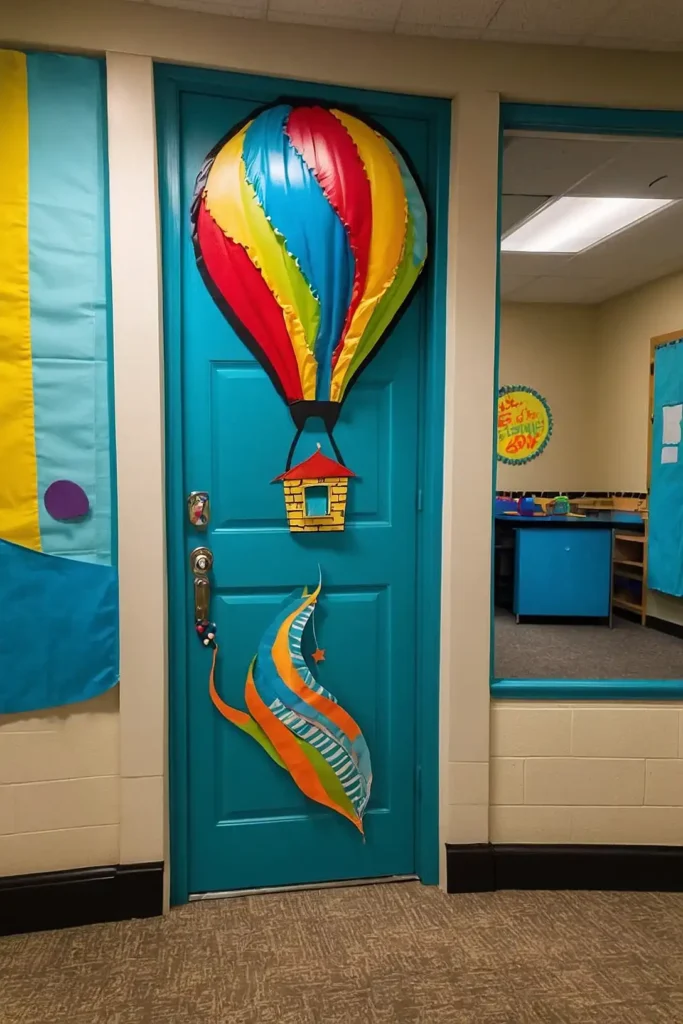
Transform your door into an inspirational hot air balloon scene from “Oh, The Places You’ll Go.”
Create a colorful balloon at the top with a basket at the bottom containing student photos or names.
Add fluffy white cotton ball clouds and the famous quote “You’re off to great places!” across the top. This uplifting design sets a perfect tone for the school year.
Include mountains and landscapes at the bottom to complete the journey theme. Students will be inspired every time they enter your classroom.
2: Cat in the Hat Door Takeover
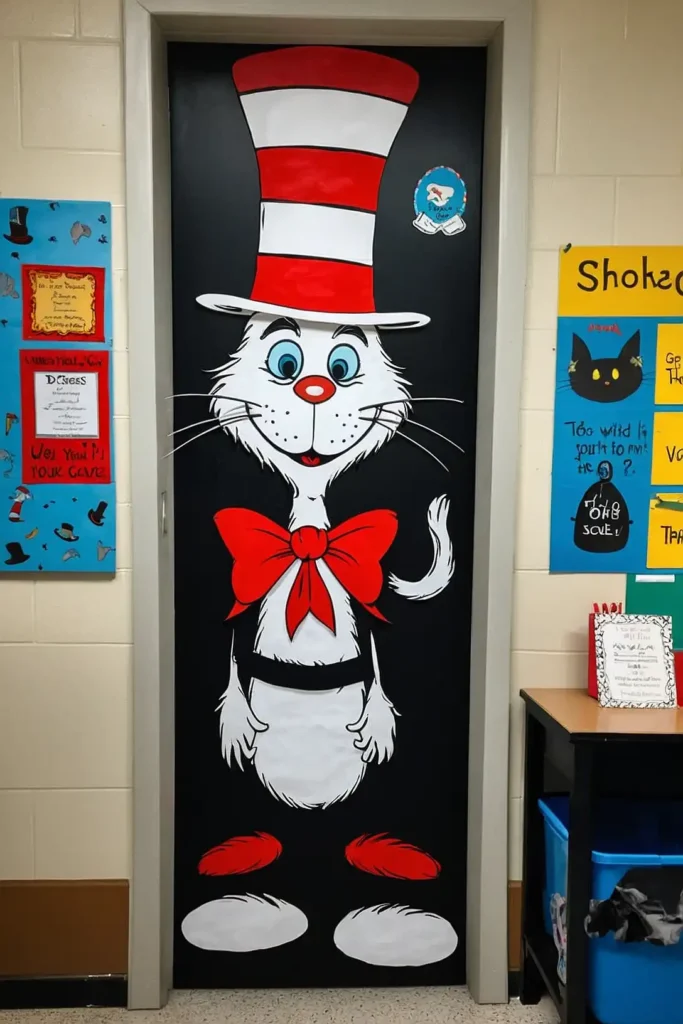
Convert your entire door into the Cat in the Hat’s iconic red and white striped hat. Create a simple black oval at the bottom with the cat’s distinctive bow tie.
Add googly eyes and whiskers peeking out from the black face section. The bold colors create an eye-catching display visible from down the hallway.
Consider attaching a 3D element like the cat’s gloved hands appearing to open the door. This playful touch adds an interactive element students will love.
3: Thing 1 and Thing 2 Double Doors
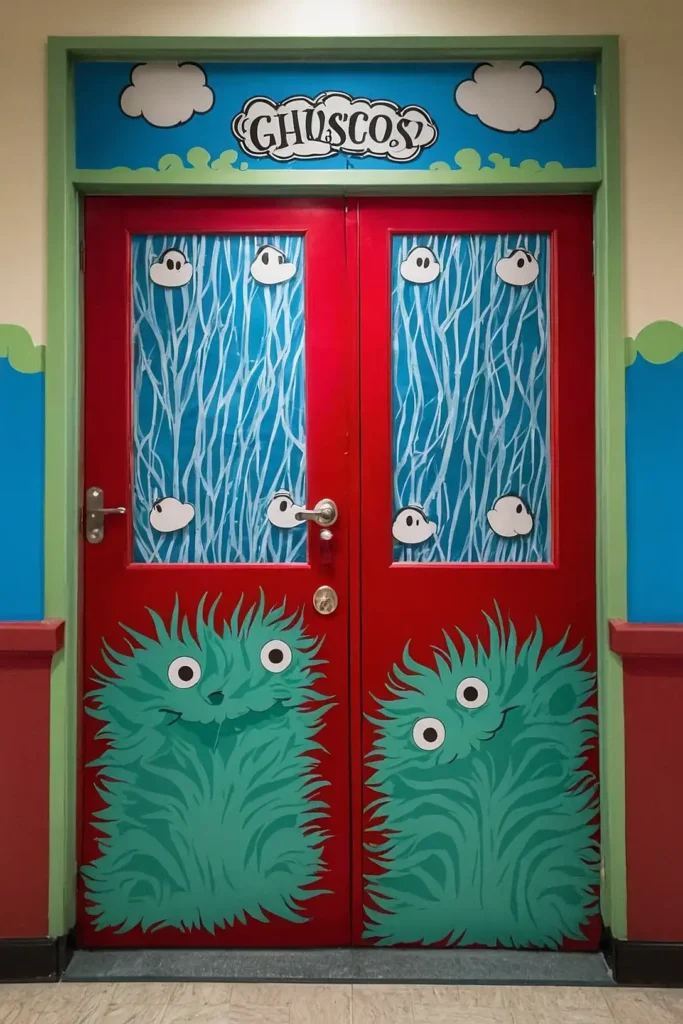
For classrooms with double doors, turn each one into Thing 1 and Thing 2. Create wild blue hair with tissue paper or streamers flowing from the top of each door.
Add red circles with “Thing 1” and “Thing 2” labels in the center of each door.
Include simple drawn faces with mischievous expressions to capture the characters’ personalities.
For single doors, divide the door vertically to achieve the same effect. This works especially well for partner teaching classrooms.
4: Truffle Trees Forest
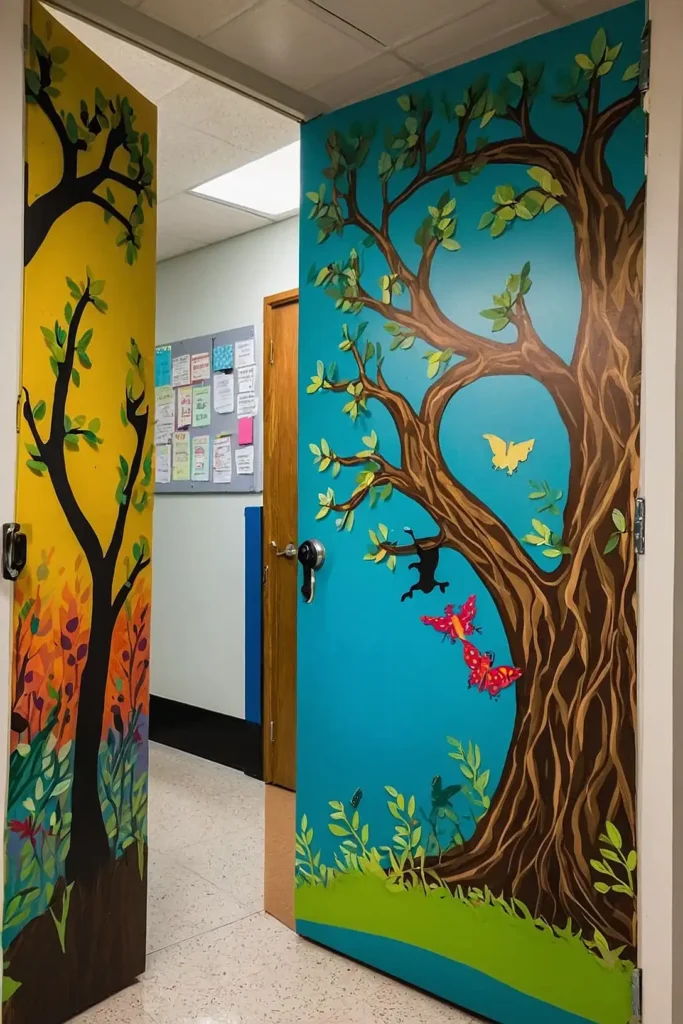
Transform your door and surrounding wall space into a colorful Lorax-inspired Truffle Tree forest.
Create fluffy tree tops using pom-poms, tissue paper, or tulle in bright colors.
Add brown paper trunk sections and the Lorax character peeking from behind a tree.
Incorporate the message “Unless someone like you cares a whole awful lot, nothing is going to get better. It’s not.”
This environmentally-themed door works perfectly for Earth Day or science units on conservation.
Students can add their own environmental pledges on paper leaves.
5: Green Eggs and Ham Breakfast Scene
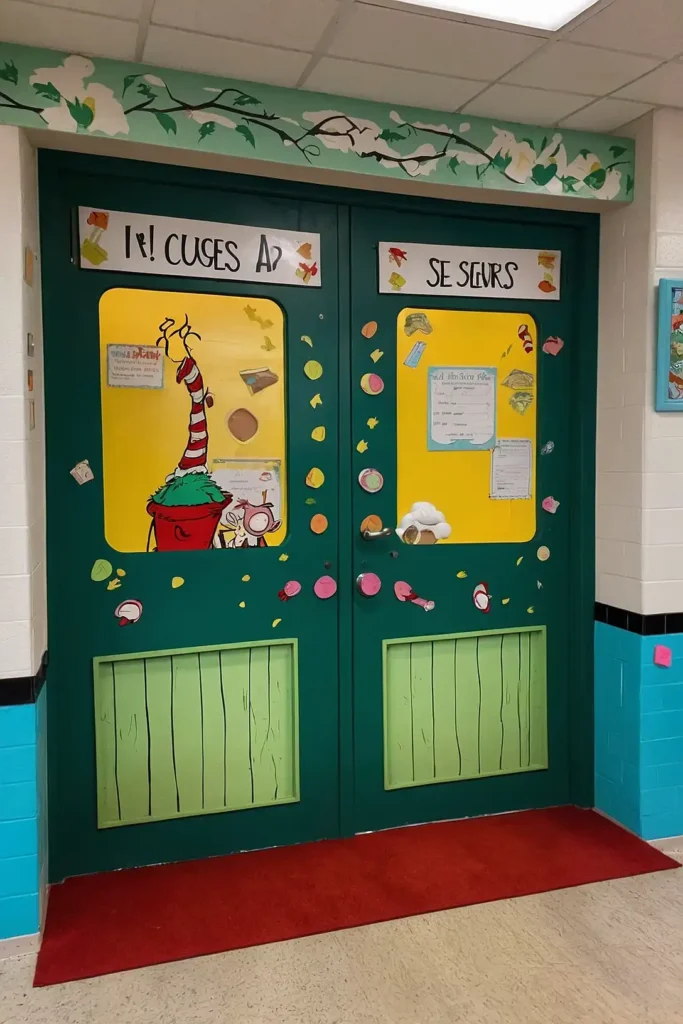
Design your door as a giant plate of green eggs and ham. Create a white paper plate background with green paper eggs and pink ham cutouts.
Add utensils, a napkin, and maybe a glass of orange juice to complete the place setting.
Include speech bubbles with quotes like “I do so like green eggs and ham! Thank you! Thank you, Sam-I-am!”
This design works especially well for younger grades and can support units on food, nutrition, or trying new things.
Students can add what new things they’re willing to try.
6: Whoville Christmas Scene
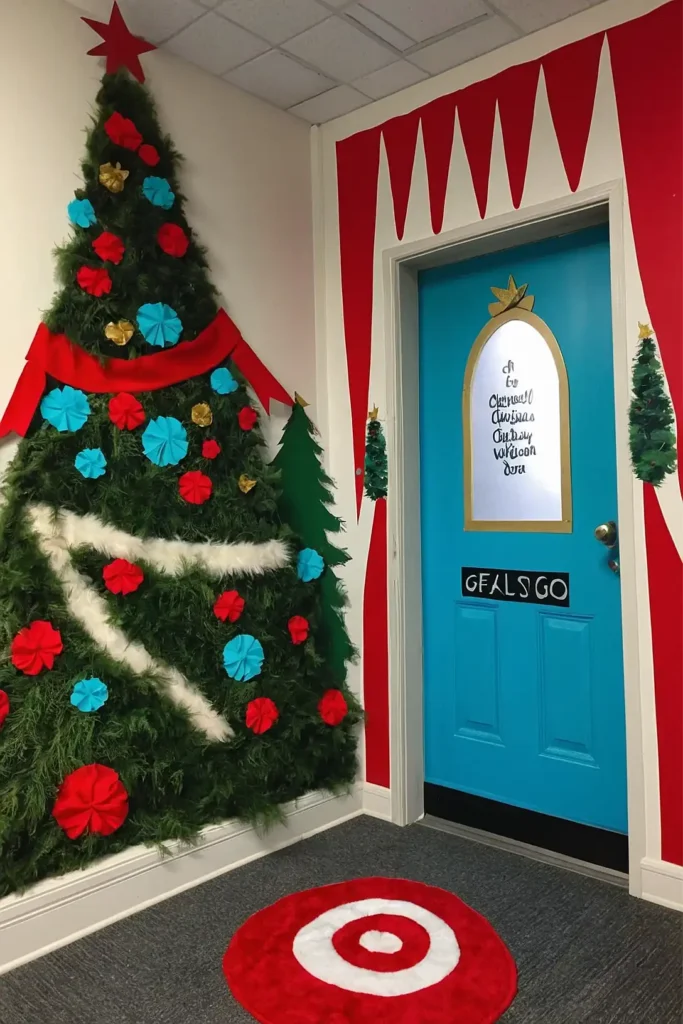
Turn your door into a festive Whoville scene from “How the Grinch Stole Christmas.”
Create curved, whimsical Whoville buildings with bright colors and irregular shapes.
Add the Grinch peeking from the top corner with his heart “growing three sizes.”
This theme works perfectly for December but can be adapted for year-round use without the Christmas elements.
Include Who characters holding hands in a circle for a community-focused message.
This door celebrates both literacy and values like forgiveness and togetherness.
7: One Fish, Two Fish, Red Fish, Blue Fish

Create an underwater scene featuring the iconic fish from this beloved book. Use different colored paper to create various fish swimming across your door.
Add counting elements by grouping fish in numbered sets. Include the rhyming text winding through the water between the colorful fish.
This design works wonderfully for kindergarten and early elementary classes focusing on colors and counting.
Consider adding student names to individual fish.
8: Horton Hears a Who Elephant
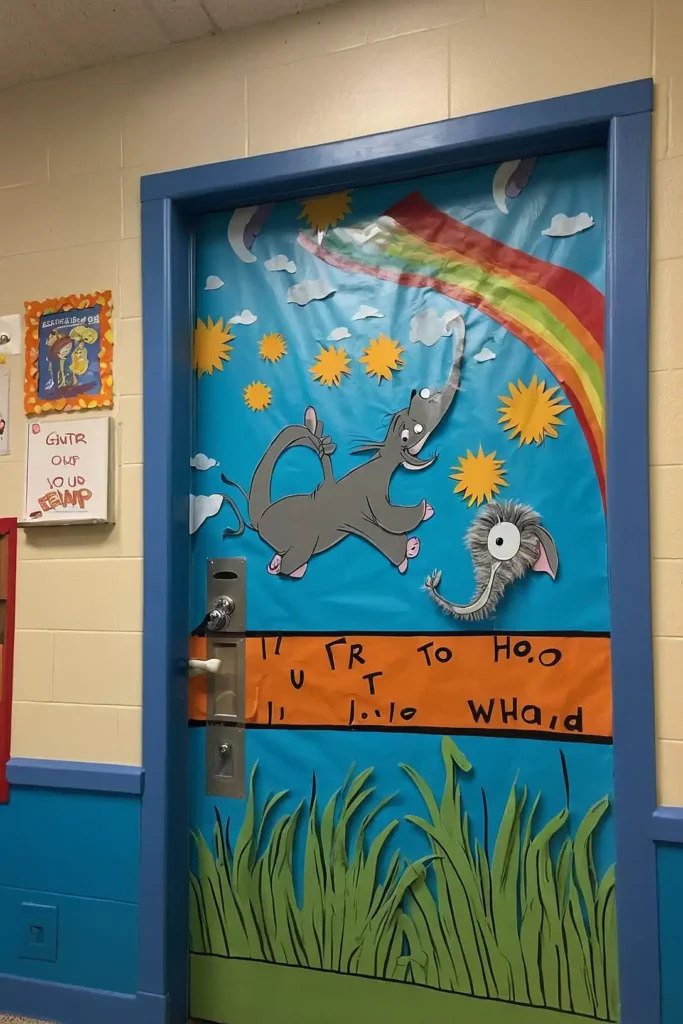
Transform your door into Horton the elephant, holding the tiny speck containing Whoville.
Create a gray elephant face with large ears extending beyond the door frame.
Add a small puff of cotton or pom-pom to represent the speck of dust. Include the quote “A person’s a person, no matter how small” to emphasize inclusivity.
This door works beautifully for teaching compassion, empathy, and the importance of standing up for others.
Students can write their promises to help others on small dust specks.
9: Yertle the Turtle Stacking Turtles
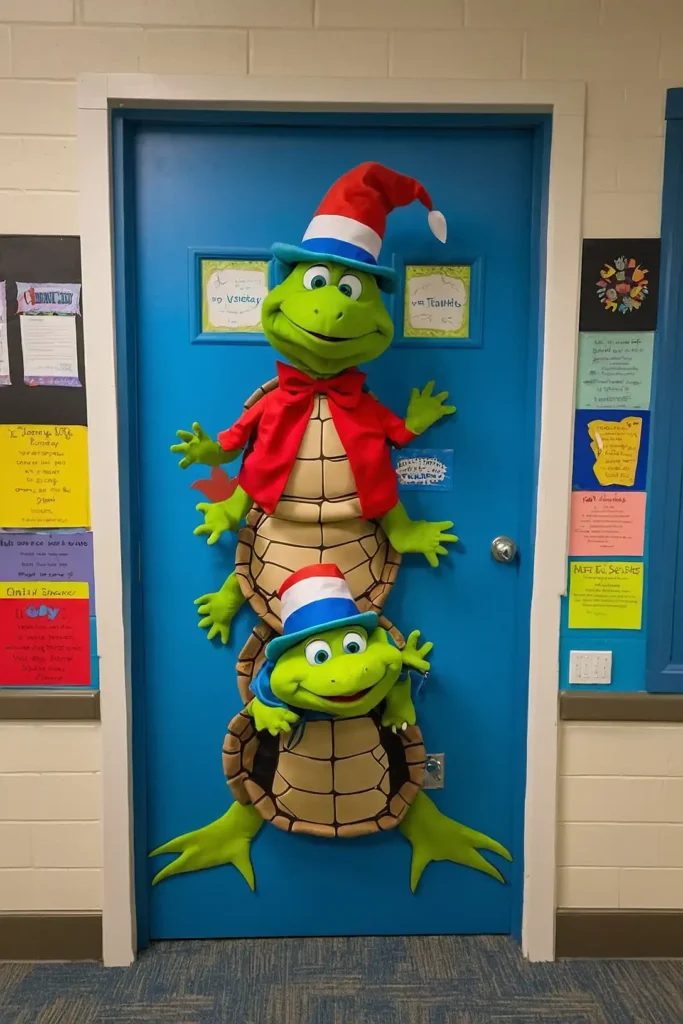
Design a stack of turtles climbing up your door to represent Yertle’s turtle tower. Create a sequence of turtles decreasing in size as they reach toward the top.
Add speech bubbles with quotes from the story about fairness and equality. Include Yertle at the top looking proud (until his inevitable fall).
This design teaches important lessons about leadership and considering others’ needs. Students can write leadership qualities on small turtle cutouts to add to the display.
10: The Sneetches Star-Bellied Door
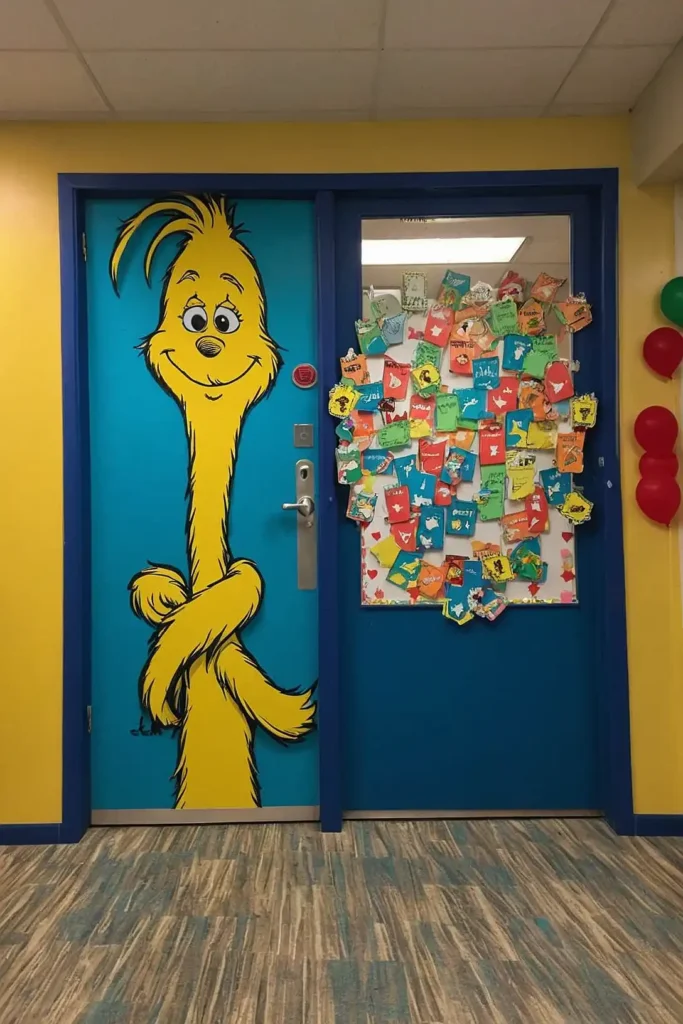
Divide your door into star-bellied and plain-bellied Sneetches. Create simple yellow Sneetch cutouts, some with green stars on their bellies and some without.
Add the quote “The day they decided that Sneetches are Sneetches and no kind of Sneetch is the best on the beaches.”
This design teaches powerful lessons about discrimination and acceptance.
Consider creating a “star-on” and “star-off” machine on either side of the doorway.
This door decoration opens up important conversations about inclusion and equality.
11: Fox in Socks Word Play
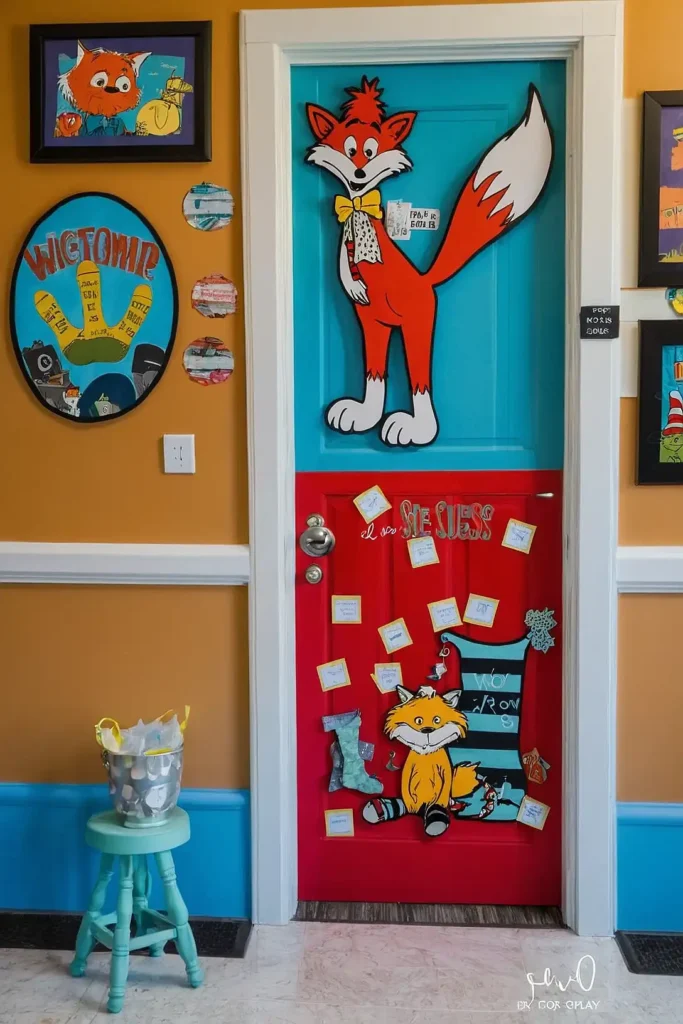
Cover your door with tongue twisters from “Fox in Socks.”
Create a central Fox character wearing blue socks surrounded by words from the book’s famous tongue twisters.
Add colorful Knox box, chicks with bricks, and other elements from the story. Challenge students to practice and perform the tongue twisters as they enter the room.
This literacy-focused door helps students develop phonological awareness and reading fluency.
Consider changing the tongue twisters weekly for ongoing engagement.
12: If I Ran the Zoo Fantasy Creatures
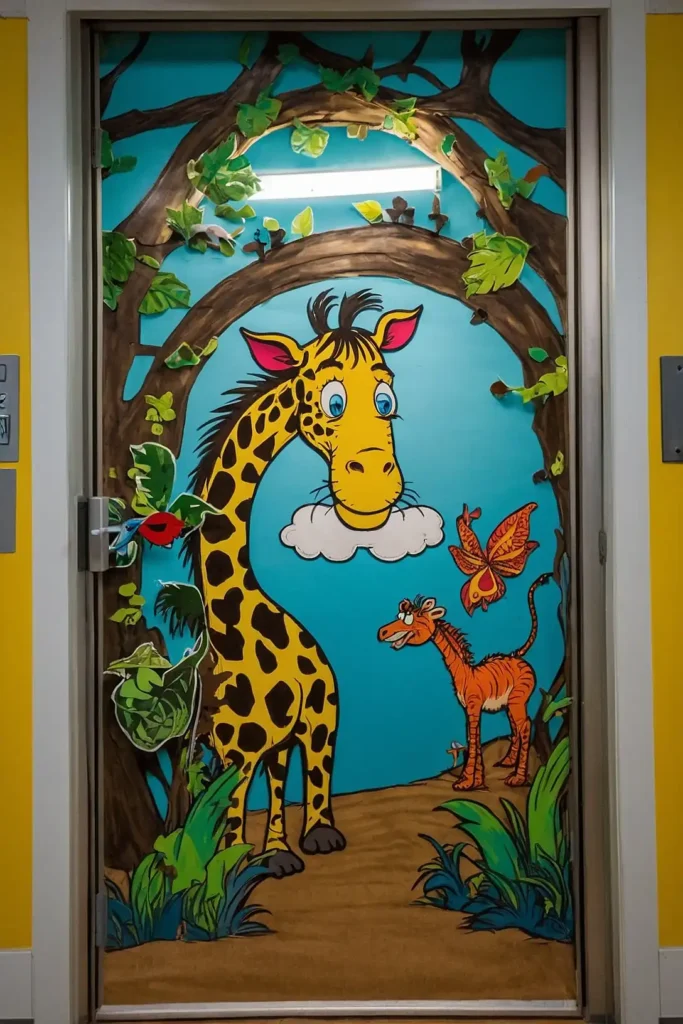
Fill your door with Gerald McGrew’s fantastic imaginary creatures from “If I Ran the Zoo.” Create colorful, whimsical animals with unusual features and silly names.
Add a zoo entrance arch at the top of the door with the book title. Include speech bubbles with the names of made-up creatures like the “Fizza-ma-Wizza-ma-Dill.”
This imagination-sparking door can connect to creative writing activities. Students can design their own fantasy creatures to add to the display throughout the year.
13: The Butter Battle Book Peace Door
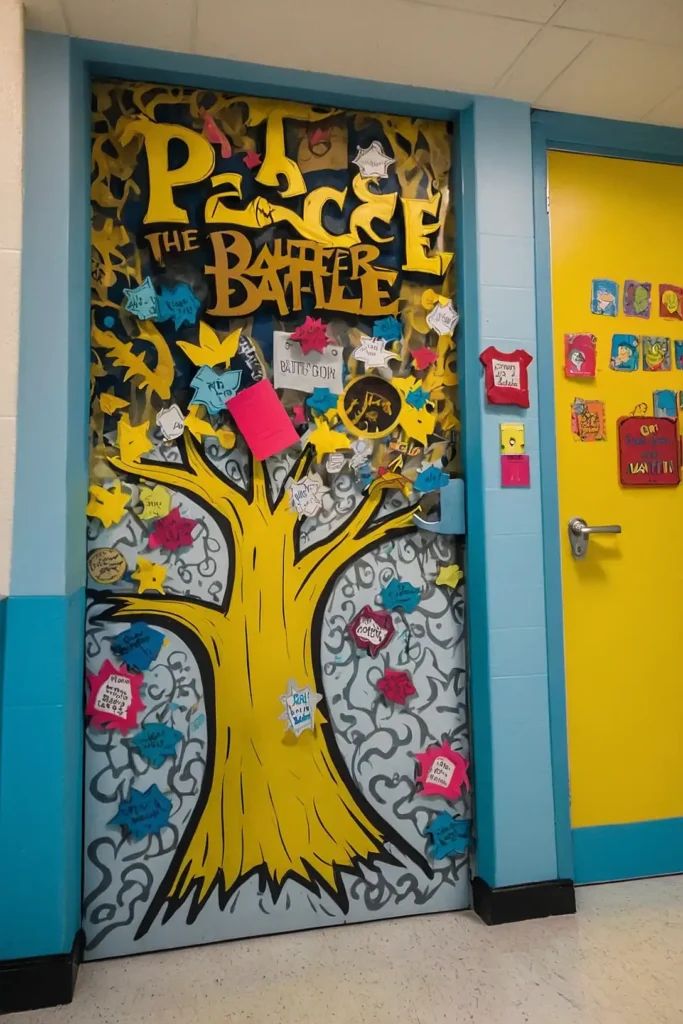
Transform your door into a peace-promoting display inspired by “The Butter Battle Book.” Create the wall with Yooks on one side and Zooks on the other.
Add bread slices showing butter-side-up and butter-side-down preferences.
Include the message “We can disagree without fighting” to emphasize conflict resolution.
This timely door teaches important lessons about resolving differences peacefully. Students can add their conflict resolution strategies on small bread slice cutouts.
14: There’s a Wicket in My Pocket Rhymes
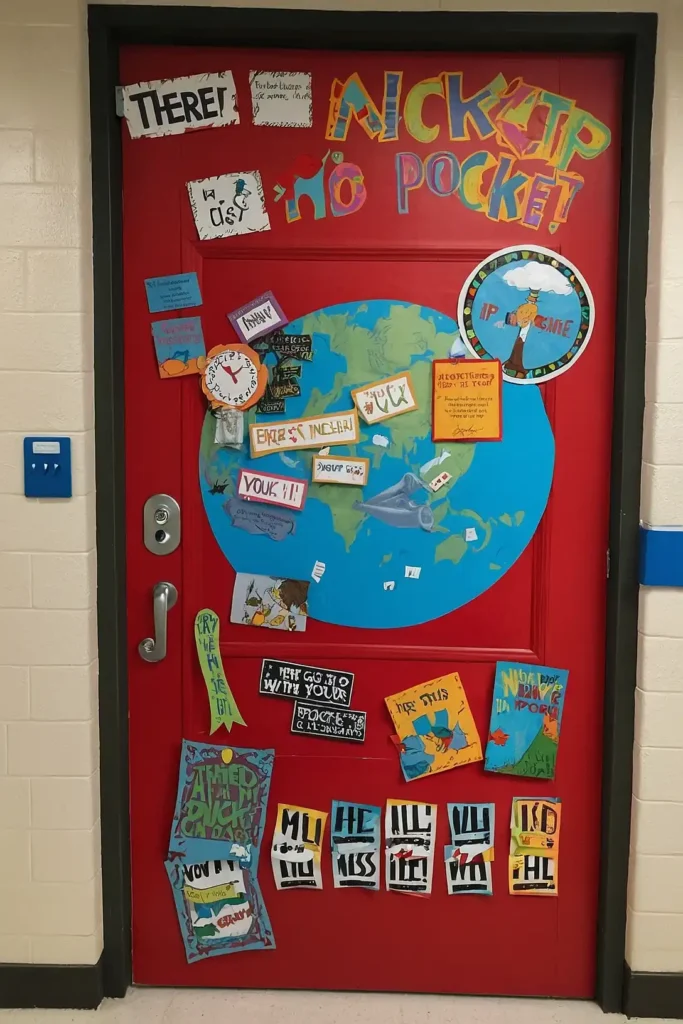
Fill your door with the silly household creatures from “There’s a Wocket in My Pocket.” Create colorful characters like the Wocket, Bofa, Nooth Grush, and Yottle.
Pair each creature with the household item it rhymes with. Add pockets, socks, and other everyday objects to house the whimsical creatures.
This phonological awareness-building door supports rhyming skills development. Students can create their own rhyming creatures to add throughout the year.
15: Sleep Book Bedtime Door
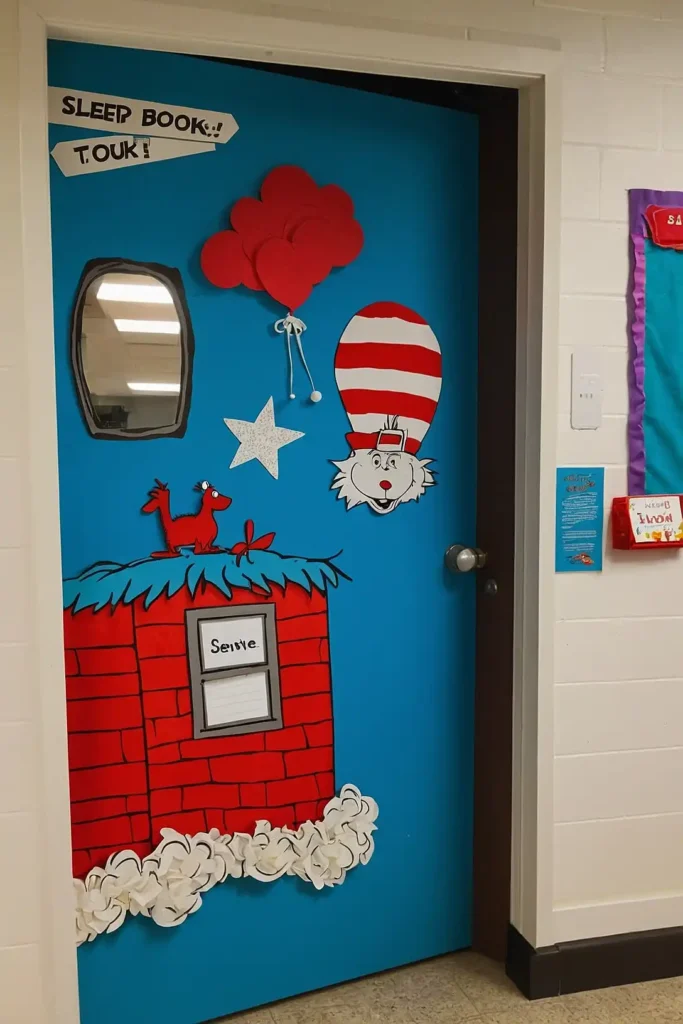
Design a restful door inspired by “Dr. Seuss’s Sleep Book.” Create sleeping creatures in beds, on clouds, and in unusual places across your door.
Add yawning faces, sleep bubbles with Z’s, and the sleep counter tracking how many creatures are sleeping.
Include the opening yawn spreading across the 99½% of Seuss creatures.
This calming door works wonderfully for naptime or quiet reading areas. It can also teach sleep hygiene during health units.
16: Oh, The Thinks You Can Think Thought Bubbles
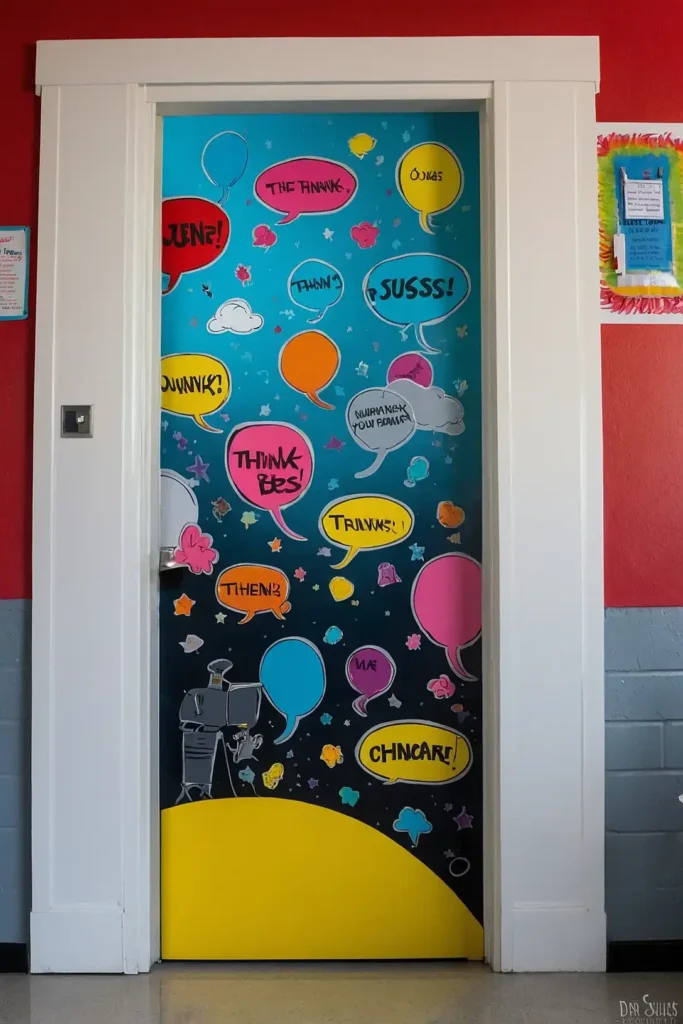
Fill your door with colorful thought bubbles containing student ideas inspired by “Oh, The Thinks You Can Think.”
Create a central character with a rainbow of thought bubbles radiating outward.
Include quotes about imagination and creativity from the book. Add whimsical Seussian backgrounds and creatures around the edges.
This creativity-focused door celebrates student imagination. Leave blank thought bubbles for students to fill in with their own “thinks” throughout the year.
17: Bartholomew and the Colbeck Slime Door
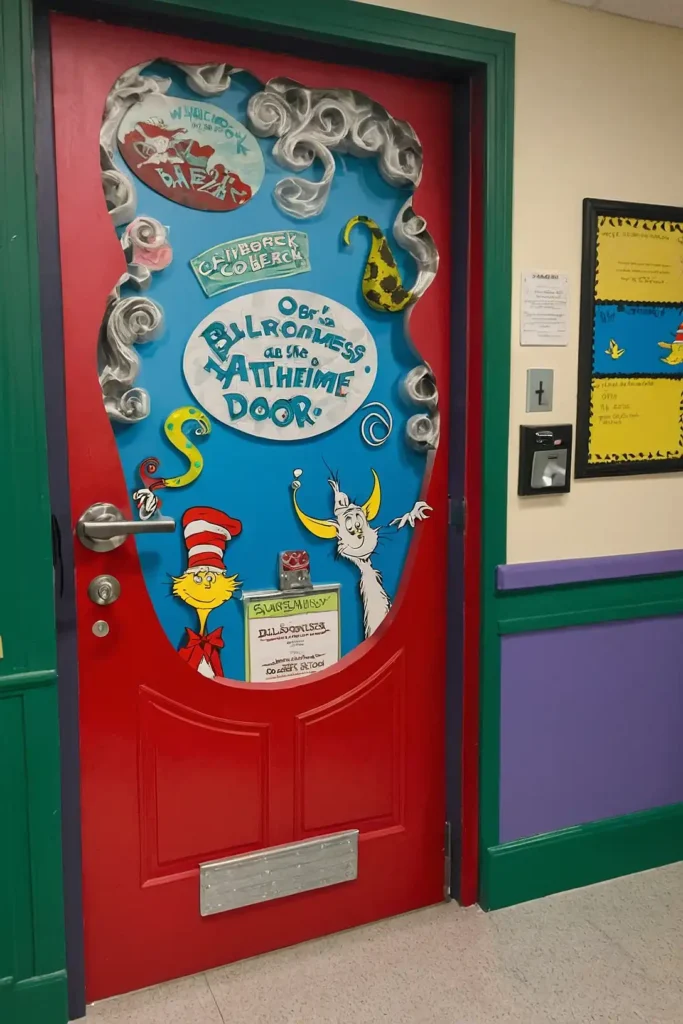
Create a door covered in green “Colbeck” dripping from the top. Use green paper cutouts or actual slime in sealed plastic pouches for a 3D effect.
Add King Derwin looking frustrated and Bartholomew looking worried. Include the lesson about saying “I’m sorry” from the book’s conclusion.
This door connects perfectly with science lessons on states of matter and actual
Colbeck slime making. Students can write what they learned from their Colbeck experiments around the door.
18: The 500 Hats of Bartholomew Cubbins

Cover your door with a towering stack of increasingly fancy hats. Create a sequence of hats that grow more elaborate as they reach the top of the door.
Add Bartholomew at the bottom looking confused at this magical phenomenon. Include the King and other characters from the story along the side.
This lesser-known Seuss book makes a uniquely eye-catching door. Students can design their own fancy hats to add to the collection throughout the year.
19: Did I Ever Tell You How Lucky You Are?

Create a desert scene with the old man on top of his cactus. Surround him with speech bubbles containing examples of people who are less fortunate from the book.
Add student photos or names with reasons they feel lucky or grateful. Include the quote “When you think things are bad, when you feel sour and blue…”
This gratitude-focused door promotes positive thinking and perspective. Students can add new “lucky” thoughts throughout the year on small desert flower cutouts.
20: Daisy-Head Mayzie Flower Power
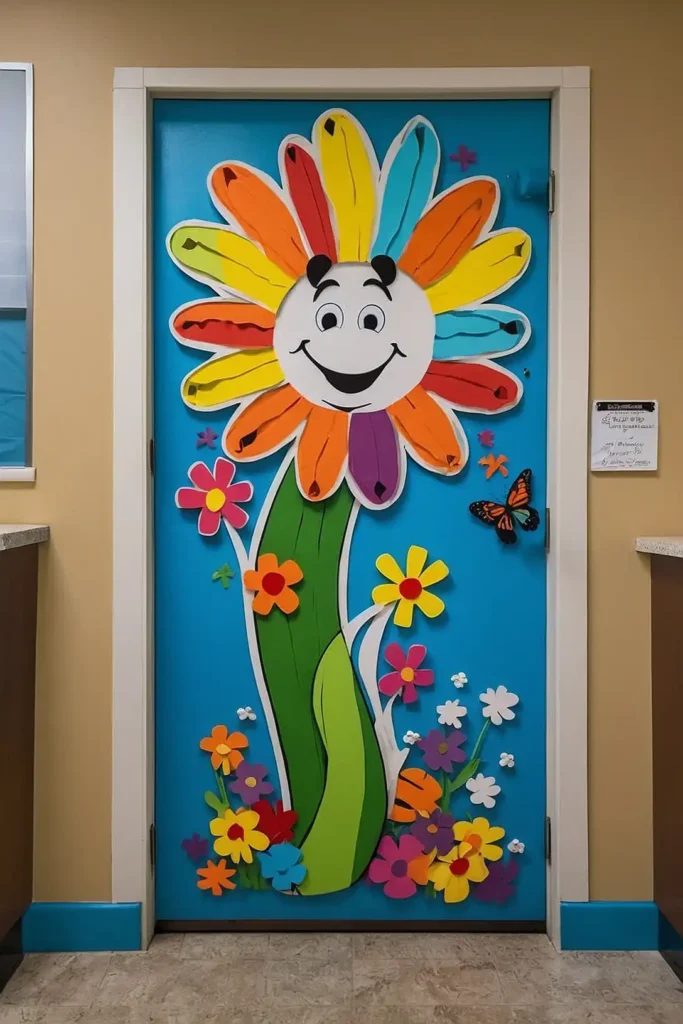
Transform your door into Daisy-Head Mayzie with a giant daisy growing from her head. Create Mayzie’s face at the bottom with a large daisy extending upward.
Add the agents, media, and attention-seekers from the story around the edges. Include the message about being yourself and true friendship from the book’s conclusion.
This door celebrates individuality and authentic relationships. Students can write about what makes them unique on small daisy petals to add to the display.
21: I Can Read With My Eyes Shut!
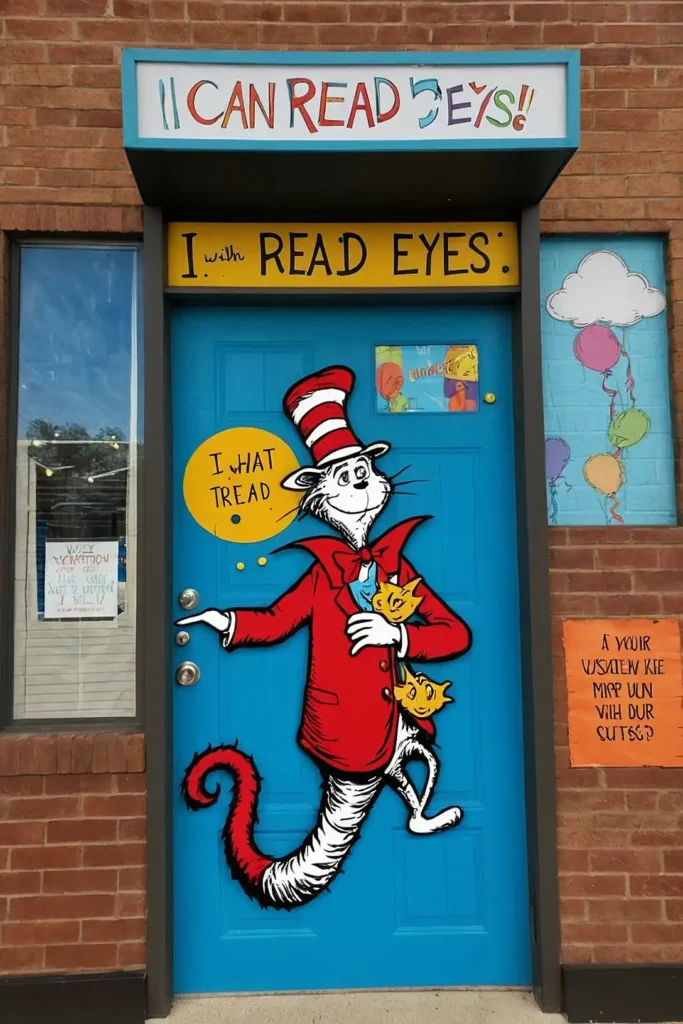
Design your door around the Cat in the Hat reading with one eye open. Create a winding path of books and words flowing across the door in colorful swirls.
Add quotes about the importance of reading and learning. Include the message “The more that you read, the more things you will know” prominently.
This literacy-promoting door celebrates the power of reading. Students can add titles of books they’ve read on small book cutouts throughout the year.
22: Mr. Brown Can Moo, Can You? Sound Effects
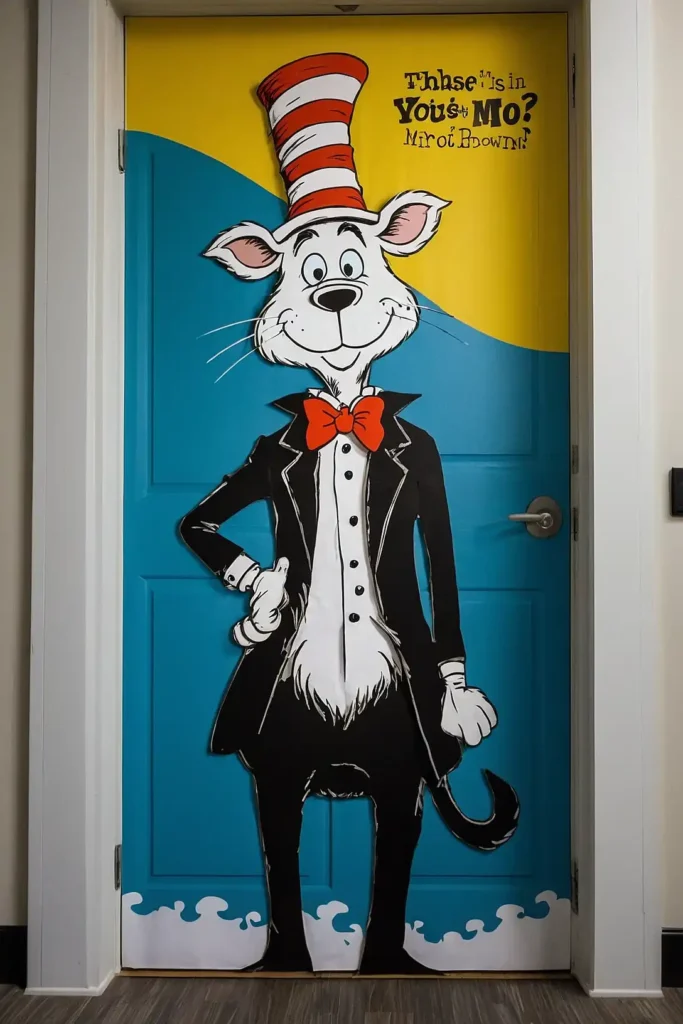
Fill your door with Mr. Brown and his amazing sound effects. Create colorful sound word bubbles (BUZZ, DIBBLE, DOPP, etc.) bursting from Mr. Brown’s mouth.
Add the animals and objects making each sound around the periphery. Include interactive elements where students can match sounds to sources.
This phonological awareness door helps students connect written onomatopoeia with sounds. Students can add their own sound words after sound scavenger hunts.
23: And to Think That I Saw It on Mulberry Street

Transform your door into Marco’s fantastic parade from Mulberry Street. Start with a simple horse and wagon at the bottom, evolving into the elaborate parade at the top.
Add elephants, giraffes, brass bands, and all the imaginative elements Marco adds to his story. Include the contrast between reality and imagination in this classic tale.
This door celebrates the power of creativity while acknowledging truth. Students can add their own imaginative elements to the parade throughout the year.
24: What Pet Should I Get? Decision Door
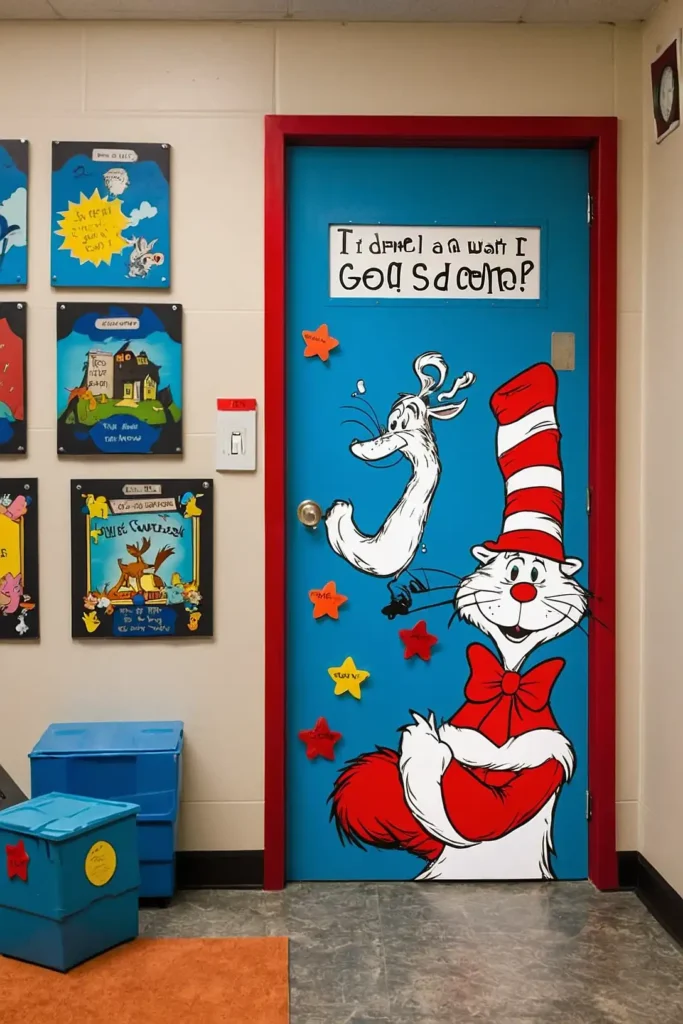
Design your door as a pet shop window filled with potential pets. Create the brother and sister from the story looking confused about which pet to choose.
Add thought bubbles showing their considerations and concerns. Include both realistic and fantastical Seussian pet options in the display.
This decision-making door supports lessons on making choices and weighing options. Students can add their own ideal pets with reasons for their choices.
25: The Lorax Speak for the Trees

Create an environmental awareness door focused on the Lorax. Design a prominent Lorax figure “speaking for the trees” with a serious expression.
Add Before and After sections showing the beautiful Truffle forest and the polluted aftermath.
Include the famous quote “Unless someone like you cares a whole awful lot…”
This eco-conscious door supports environmental science units. Students can add their environmental protection pledges on small Truffula seed cutouts.
26: Dr. Seuss Character Collage
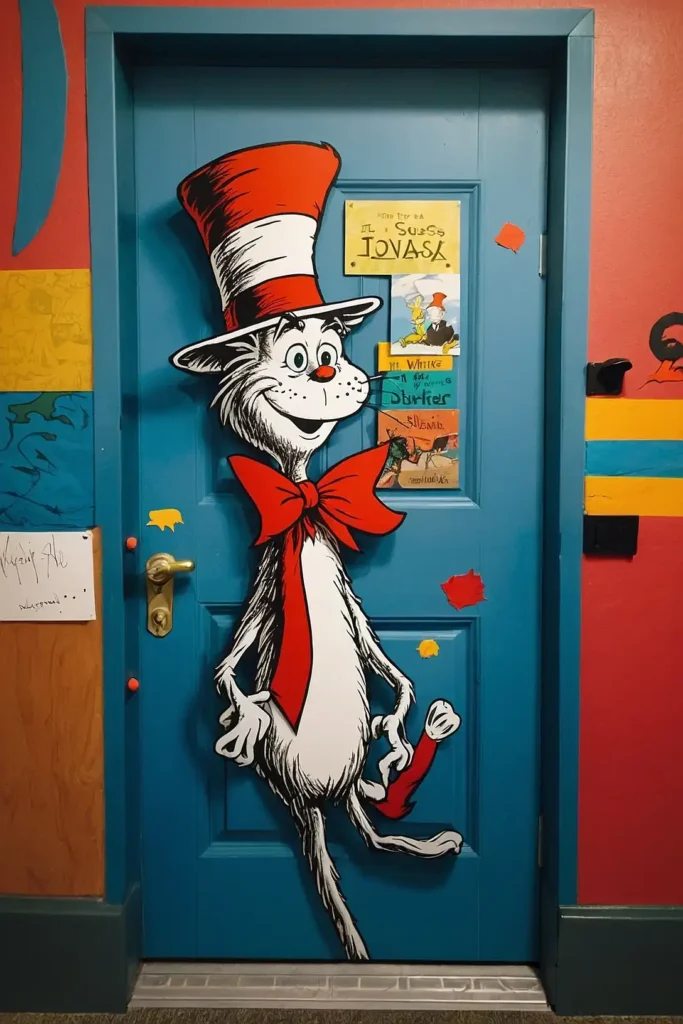
Fill your door with a collage of beloved Dr. Seuss characters. Include the Cat in the Hat, Horton, the Grinch, Sam-I-Am, and dozens of others in a colorful arrangement.
Add famous quotes from various books winding between the characters. Create a border of red and white stripes reminiscent of the Cat’s hat.
This comprehensive door celebrates the breadth of Seuss’s work. Students can add speech bubbles with their favorite quotes as they read different Seuss books.
27: Hop on Pop Word Families

Design your door around word families from “Hop on Pop.” Create visual representations of simple word chunks like “UP,” “AT,” and “ALL” with their word family members.
Add characters from the book demonstrating the actions (hopping on Pop, Mr. Brown upside down, etc.). Include interactive elements where students can build new words.
This phonics-focused door supports early reading skills. Students can add new words they discover to each word family throughout the year.
28: How the Grinch Stole Christmas Heart Growth
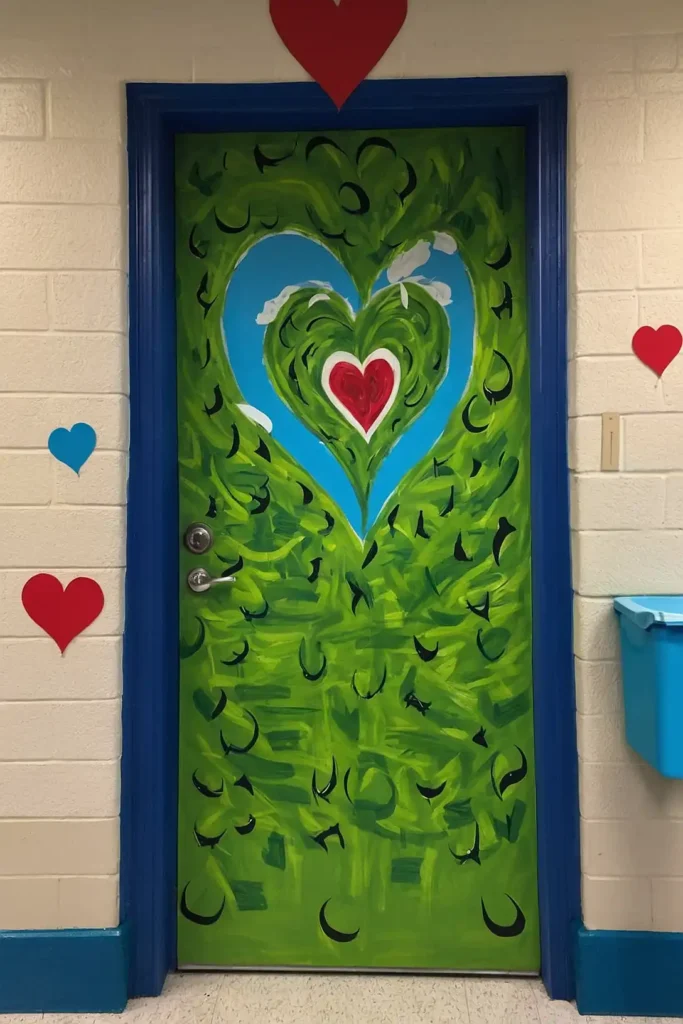
Create a door focused on the Grinch’s heart growing three sizes.
Design a large Grinch face with a small heart that extends outward (potentially using accordion-folded paper).
Add Who characters holding hands around the edges. Include the quote about the true meaning of Christmas transcending presents.
This character development door works year-round by focusing on kindness.
Students can write kind actions on small heart cutouts to add to the growing heart.
29: Ten Apples Up On Top Balancing Act

Design a door showing characters balancing increasing numbers of apples on their heads. Create a sequence going from one apple to ten, climbing up your door.
Add the lion, dog, and tiger from the story attempting their precarious balancing acts. Include counting elements to reinforce number skills.
This mathematical door supports counting and number sequence lessons. Students can add their own balancing challenges on small apple cutouts.
30: The Cat’s Hats from The Cat in the Hat Comes Back

Create a door showing the alphabetical sequence of Little Cats emerging from the Cat’s hat. Design nested hats with cats of decreasing size from A to Z.
Add the pink ring cleaning sequence from the story around the edges. Include the “VOOM” that finally cleans up the mess at the conclusion.
This alphabet-reinforcing door supports letter recognition. Students can add objects starting with each letter alongside the corresponding Little Cat.
31: Melilot’s Pool Imagination Ocean
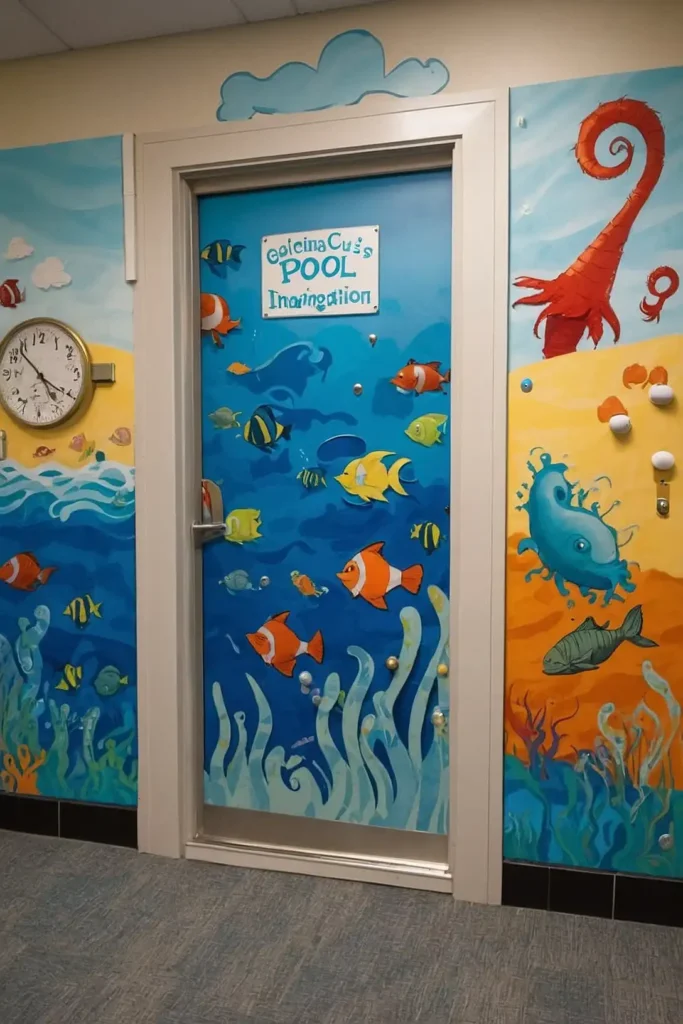
Transform your door into the imaginative fish-filled pool from “Melilot’s Pool.” Create a simple farm pond at the top that transforms into a fantastic ocean below.
Add increasingly strange and wonderful fish as you move down the door. Include Marco dreaming at the top with his fishing pole.
This imagination-celebrating door encourages thinking beyond the obvious. Students can design their own fantastical fish to add to the deepening ocean.
32: Scrambled Eggs Super! Exotic Birds

Fill your door with the exotic birds from “Scrambled Eggs Super!” Create Peter T. Hooper proudly displaying his unusual egg collection.
Add fantastical birds like the Tizzle-Topped Grouse and Sala-ma-goox with their distinctive features. Include nests with colorful spotted and striped eggs.
This creative door celebrates imagination and adventure. Students can create their own bird species with special features to add to the collection.
33: Dr. Seuss Quotes Inspiration

Cover your door with inspirational quotes from various Dr. Seuss books.
Create colorful speech bubbles, banners, and thought clouds containing wisdom from Seuss.
Include quotes about learning, kindness, imagination, and perseverance. Add small character vignettes next to their corresponding quotes.
This motivational door provides daily inspiration. Students can nominate their favorite quotes to add to the display as they discover them.
34: Dress Up Your Teacher Door Challenge

Create a door where the Cat in the Hat helps students dress up their teacher.
Design a teacher silhouette with Velcro or magnetic attachments for Seuss-themed accessories.
Add a rack of silly hats, ties, socks, and other clothing items inspired by Seuss characters. Include a challenge chart tracking creative combinations.
This interactive door engages students daily. Create a rotation system where different students get to choose the outfit components each day.
35: Marvin K. Mooney, Will You Please Go Now!
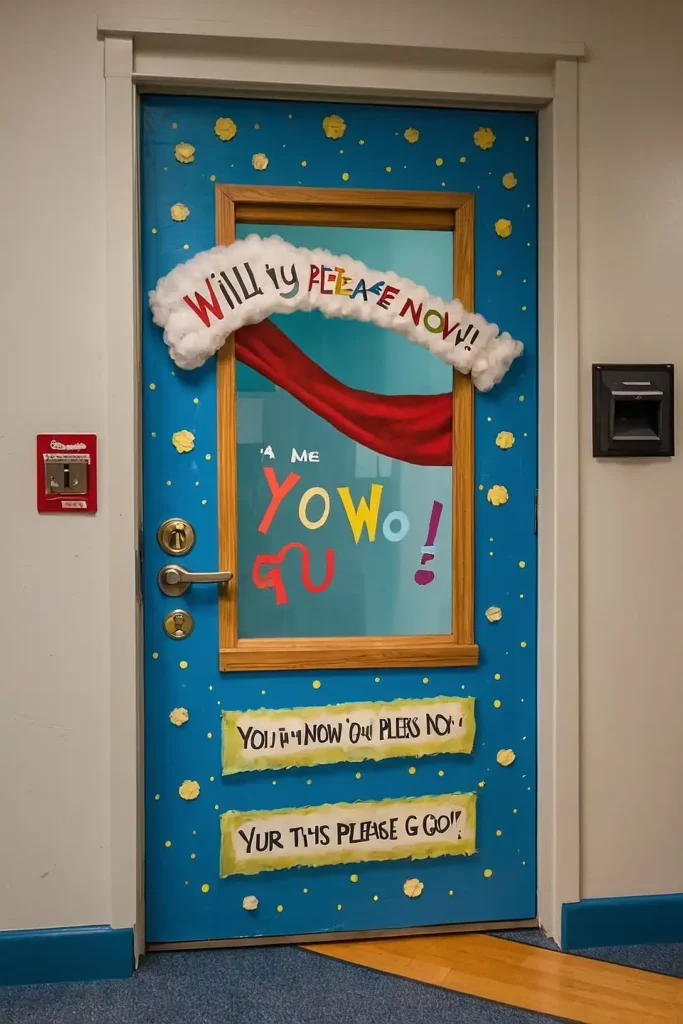
Design a door showcasing all the silly ways Marvin could leave. Create Marvin with various transportation options—Zumble-Zay, Crunk-Car, and other fantastical vehicles.
Add a pathway leading to your classroom with stopping points for each vehicle. Include the repeated refrain “Will you please go now!” in large lettering.
This humorous door celebrates imagination and wordplay. Students can design additional transportation methods for Marvin on small vehicle cutouts.
Conclusion
Transform your classroom entrance with these whimsical Dr. Seuss door decorations that celebrate reading, imagination, and creativity.
Which of these Seuss Ian designs will welcome your students to a world of learning?



